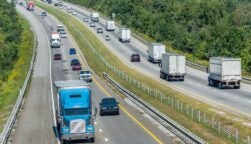Indiana and Ohio officials have agreed to a partnership that would see self-driving trucks on the interstate highway connecting the two states.
Self-driving trucks have been promised by tech and logistics businesses for years, but we’re just now starting to see the industry make actual headway. Some companies are launching full-on automated vehicles, while others are still testing the technology on roadways in the US.
This instance will be nothing more than a test for now, but the interstate cooperation bodes well for an industry on the cusp of a big change.
ODOT and IDOT Partner for Self-Driving Trucks on I-70
According to a joint statement, the Ohio Department of Transportation (ODOT) and the Indiana Department of Transportation (IDOT) have agreed to a partnership that will bring self driving trucks to I-70, the interstate highway that connects Indianapolis, Indiana and Columbus, Ohio.
The partnership will operate with an $8.8 million budget from the US Department of Transportation over the course of multiple years.
 This just in! View
This just in! View
the top business tech deals for 2025 👨💻
“Harnessing truck automation technology is one of many innovative safety efforts underway at INDOT. In partnership with Ohio, our goal is to create a safer, lower-stress environment for all drivers.” – Lyndsday Quist, Commissioner at INDOT
Are These Trucks Fully Automated?
If you’re driving down I-70 in the future and you see a truck driving without a driver, you should still be concerned, as fully automated trucks are not part of this partnership.
Instead, the technology that will be employed on the interstate highway between Ohio and Indiana is automated platooning, a system that allows multiple trucks to drive in close formation — like cars on a train — to improve fuel efficiency through drafting. This new technology will allow multiple trucks to be controlled by the leading truck.
“During portions of the I-70 trips, the follower truck will automatically steer, accelerate, and brake, supporting safe, efficient operation and consistent vehicle coordination. Professional drivers will be in the driver’s seat of both trucks throughout the deployment and can turn off the technology system and take over as needed.” – Natalie Garrett, a spokesperson for INDOT
While the technology may not be as groundbreaking as fully automated trucks, it will allow logistics businesses to improve the speed of hauling while safely cutting down on fuel costs. And considering safety hasn’t been a big priority for the new administration, this technology could have a notable impact.
Technology and Trucking
In 2025, every industry is becoming more and more reliant on technology, and the trucking and logistics industries are no different. Automation in particular has become a big buzz word, with tech being used to save as much time as possible throughout the supply chain.
It goes far beyond self-driving trucks, too. Generative AI tools can be used to improve your logistics business as well, and there are many AI training courses for professionals in the industry that can help you streamline operations.




